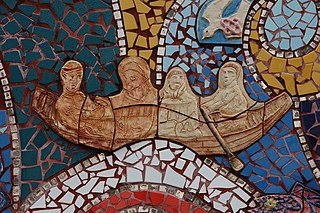
Balla is a town in County Mayo, Ireland on the N60 National secondary road, the main road between Castlebar and Claremorris. The economy of the village survives mainly on passing trade, from the busy N60 which carries over 7,000 vehicles through the town every day. It is notable for its round tower. The town is in a townland and civil parish of the same name. It used to be a significant shop and market centre. It fell into decline and lost its railway station, but has enjoyed something of a revival as a residential area for people working in Castlebar.

Saint Comgall, an early Irish saint, was the founder and abbot of the great Irish monastery at Bangor in Ireland.
Lusmagh is a civil parish in County Offaly, Ireland, bounded by three rivers: the Shannon, Lusmagh and Little Brosna to the west, east and south respectively. The town of Banagher is northeast across the River Lusmagh. Lusmagh was considered part of County Galway in 1628 and Connacht until 1373; the Lusmagh Roman Catholic parish is the only one in the Diocese of Clonfert east of the Shannon. According to the history of the O'Kellys of Hy-Many, Lusmhaigh means the plain of the healing herbs. In Christian times, the parish was named Cill Mochonna, "the Church of Mo Chua". Saint Mo Chua of Balla, also called Crónán, founded a monastery in 600 on the site of Cloghan Castle. The name Lusmagh was restored to the Catholic parish around 1810. Its parish church, named after St. Crónán, is about three miles southwest of Banagher.

Donatus of Fiesole was an Irish teacher and poet, and Bishop of Fiesole.

Aaron of Aleth, also called Saint Aihran or Eran in Breton, was a hermit, monk and abbot at a monastery on Cézembre, a small island near Aleth, opposite Saint-Malo in Brittany, France. Some sources suggest he may have migrated from Celtic Britain to take up residence in Armorican Domnonia.
Fintan of Clonenagh was an Irish hermit and monk. He was an abbot and disciple of Columba of Terryglass.
Colman mac Cathbaid is a sixth-century Irish saint who was an abbot and bishop of Kilroot, a minor see which was afterwards incorporated in the Diocese of Connor. He may have given his name to Kilmackevat.
Columba of Terryglass (Colum) was the son of Ninnidh, a descendant of Crinthainn, King of Leinster. Columba was a disciple of St. Finnian of Clonard. He was one of the Twelve Apostles of Ireland.
Saint Crónán was the abbot-bishop and patron of the diocese of Roscrea, Ireland. He should not be confused with his contemporary Saint Crónán Mochua.
Saint Diarmaid the Just was a Catholic abbot of Inis Clothrann (Inchcleraun), Lough Ree, County Longford and of Faughalstown, County Westmeath and a famous Irish confessor of the late-sixth century.
Saint Fintán, or Munnu is one of the saints of Ireland and Britain who served in Ireland and Scotland being the founder and abbot of the abbey at Teach-Mhunn - The House of Saint Munn - where his bed may be visited is a pilgrimage site; today Taghmon is in the County Wexford, in the province of Leinster Ireland. In Scotland, he is venerated as the patron saint of Clan Campbell.
There is archaeological evidence of insular monasticism as early as the mid 5th century, influenced by establishments in Gaul such as the monastery of Martin of Tours at Marmoutier, the abbey established by Honoratus at Lérins; the abbey of Mont-Saint-Michel; and that of Germanus at Auxerre. Many Irish monks studied at Candida Casa near Whithorn in what is now Galloway in Scotland.
Saint Cronan may refer to:
Cronan Balnae was an Irish Saint.

Mo Chutu mac Fínaill, also known as Mochuda, Carthach or Carthach the Younger, was abbot of Rahan, County Offaly, and subsequently, founder and first abbot of Lismore, County Waterford. The saint's Life has come down in several Irish and Latin recensions, which appear to derive from a Latin original written in the 11th or 12th century.
Saint Finnchu was an early Irish Saint. He was born in Brigobann, now Brigown, in the county of Cork, Ireland.

Saint Mochoemoc was an early Irish abbot, later considered to have been a saint. He was a nephew of Saint Íte of Killeedy, who raised him. He became a monk in Bangor Abbey under the abbot Saint Comgall of Bangor. He was the founding abbot of Liath-Mochoemoc (Liathmore) monastery. His feast day is 13 March.
Saint Bécán was an Irish monk who founded a monastery at Kilbeggan and is considered by some to be one of the Twelve Apostles of Ireland. His feast day is 5 April.
Saint Corbmac, also known as Cormac mac Eogain, was an Irish saint.






